Zotac ZBOX MAGNUS EN970 Review - A Gaming mini-PC Done Right
by Ganesh T S on September 28, 2015 8:00 AM ESTHTPC Credentials
Despite being actively cooled, I was pleasantly surprised by the noise profile of the system. The fans have variable rotational speeds, and in general, for most media related activities, the fan noise is minimal. I would go as far to say that the noise is probably the lowest amongst all the gaming mini-PCs that we have evaluated.
Refresh Rate Accurancy
Starting with Haswell, Intel, AMD and NVIDIA have been on par with respect to display refresh rate accuracy. The most important refresh rate for videophiles is obviously 23.976 Hz (the 23 Hz setting). The Zotac ZBOX MAGNUS EN970 does not have the same out-of-the-box accuracy possessed by Intel and AMD. However, NVIDIA also allows for setting custom resolutions and refresh rates.
The gallery below presents some of the other refresh rates that we tested out. The first statistic in madVR's OSD indicates the display refresh rate.
Network Streaming Efficiency
Evaluation of OTT playback efficiency was done by playing back our standard YouTube test stream and five minutes from our standard Netflix test title. Using HTML5, the YouTube stream plays back a 720p encoding. Since YouTube now defaults to HTML5 for video playback, we have stopped evaluating Adobe Flash acceleration. Note that only NVIDIA exposes GPU and VPU loads separately. Both Intel and AMD bundle the decoder load along with the GPU load. The following two graphs show the power consumption at the wall for playback of the HTML5 stream in Mozilla Firefox (v 41.0).

GPU load and VPU load were around 16.01% and 21.42% for the YouTube HTML5 stream.GPU load in the steady state for the Netflix streaming case was 5.88% and the VPU load was 4.36%.
Netflix streaming evaluation was done using the Windows 8.1 Netflix app. Manual stream selection is available (Ctrl-Alt-Shift-S) and debug information / statistics can also be viewed (Ctrl-Alt-Shift-D). Statistics collected for the YouTube streaming experiment were also collected here.

Decoding and Rendering Benchmarks
In order to evaluate local file playback, we concentrate on EVR-CP and madVR. We already know that EVR works quite well even with the Intel IGP for our test streams.
In our earlier reviews, we focused on presenting the GPU loading and power consumption at the wall in a table (with problematic streams in bold). Starting with the Broadwell NUC review, we decided to represent the GPU load and power consumption in a graph with dual Y-axes. Nine different test streams of 90 seconds each were played back with a gap of 30 seconds between each of them. The characteristics of each stream are annotated at the bottom of the graph. Note that the GPU usage is graphed in red and needs to be considered against the left axis, while the at-wall power consumption is graphed in green and needs to be considered against the right axis.
Frame drops are evident whenever the GPU load consistently stays above the 85 - 90% mark. An important aspect to note here for NVIDIA GPUs is that the load reported doesn't take into account the GPU clock. For example, the 4Kp30 clip in the EVR-CP mode: Initially, the GPU and VPU operate at higher clocks, resulting in the reported load being 7 - 8% and the power consumption being around 34W. However, later on towards the end of the stream, the load jumps up to around 12%, but the power consumption is now only around 25 W. Essentially, the power consumption at the wall is the real metric of efficiency for decode and playback. As long as the GPU load stays below the 85 - 90% mark, frame drops don't occur.
EVR-CP and madVR Defaults don't present any challenges to the GTX 960
Since the GTX 960 is a powerful GPU, we evaluated madVR with both default and stress settings. The 'madVR stress settings' was configured with the upscaling algorithms set to Jinc 3-tap with anti-ringing activated and the downscaling algorithm set to Lanczos 3-tap, again with anti-ringing activated.
The ZBOX MAGNUS EN970 was able to handle the madVR stress configuration without any issues.
Moving on to codec support, the GTX 970M / GM204 is a known quantity with regards to the scope of supported hardware accelerated codecs.
There is no HEVC_VLD_Main10 support. This is a bit disappointing since the real desktop GTX 960 supports Main10 decoding in hardware. Other than that aspect, the ZBOX MAGNUS EN970 actually makes for a reasonably power-efficient madVR-capable HTPC.


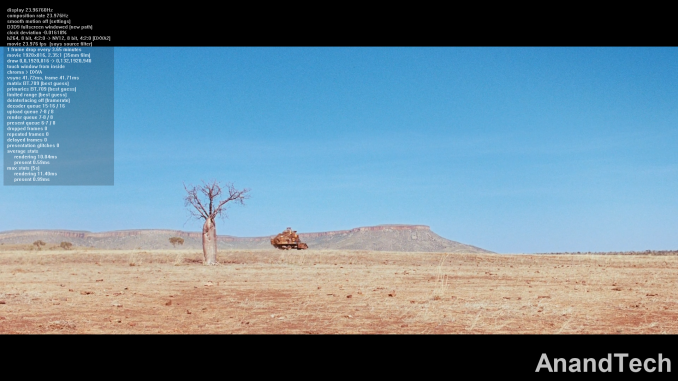



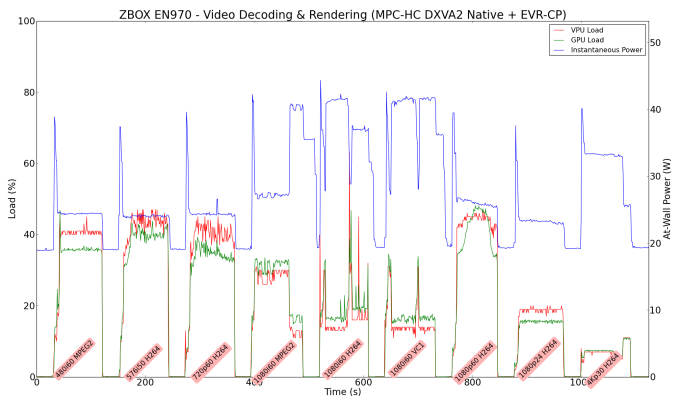
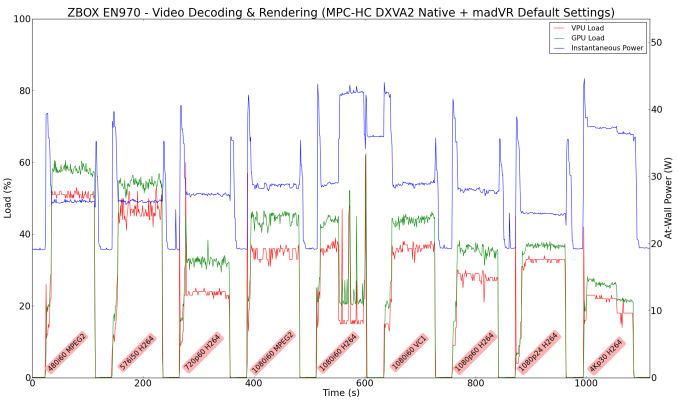
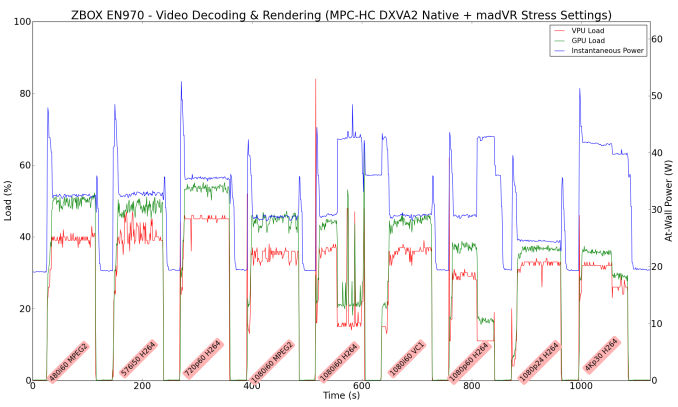
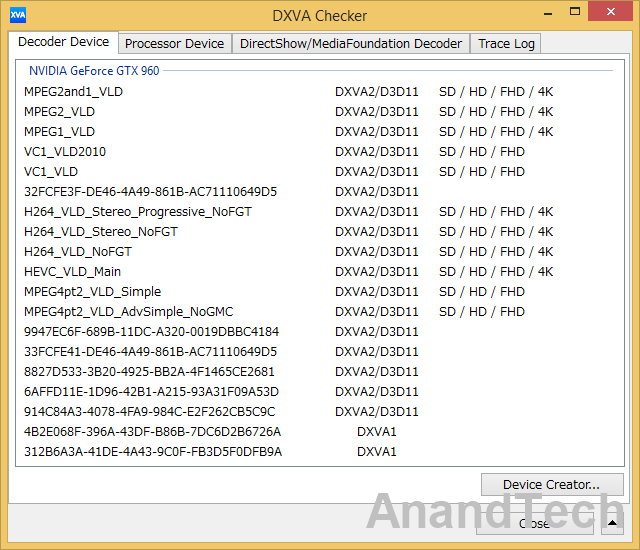








88 Comments
View All Comments
KateH - Monday, September 28, 2015 - link
I would be very curious to hear more about the GPU rebranding situation... why would a 1280-shader GM204 on an MXM card be a 970m in a laptop but a 960 non-M in a SFF? Why would Nvidia/Zotac go to the trouble of editing the VGA BIOS and drivers to make this GM204 show up as a 960 when there are already loads of MXM 970m's that are functionally identical to this aside from re-badging? The OEM GPU re-branding situation is ridiculous; Zotac/Nvidia have created a doubly confusing situation where this card could be easily confused for either a significantly-slower GM107-based GTX 960m (that's itself a rebadged 860m) or a slightly-slower GM206 GTX 960 that has the potentially-important HEVC decode that's actually not present in this "960".KateH - Monday, September 28, 2015 - link
And while I'm on a rant, re-badging between generations is ridiculous too- but I know by now that's a losing battle that's only getting worse. FFS.mapesdhs - Monday, September 28, 2015 - link
A lot of that going on by all sides, but it's hard to discuss without enraging rival armies of haters and fanboys. We'd be a lot better off if nobody did it. What really bugs me is the massive performance overlap of newer lesser models vs. older models. The naming system allows one to infer that a newer card will have a particular level of basic performance, but the reality is often very different. I benchmarked a 650 Ti recently, was amazed to find it often failed to beat an old GTX 460.lmcd - Tuesday, September 29, 2015 - link
I mean the 650 Ti should be like 2/3 the power consumption at most, no?KateH - Tuesday, September 29, 2015 - link
Yeah, something like that. ~100-120W for a 650Ti vs ~150-170W for a 460. The 660 is in the same power envelope as the 460 and should outperform it by a fair marginrtho782 - Tuesday, September 29, 2015 - link
You're perfectly right. Having a separate mobile product stack made sense when mobile gpus were way behind desktop ones, now they use the same silicon, less so.I think we should have the same product names and tiers for both, perhaps use the "m" suffix in cases where the clockspeed is much lower in the laptop variant.
KateH - Tuesday, September 29, 2015 - link
I kinda wonder if it's not time to do away with the "M" suffix for GPUs altogether and move towards segmentation based on power, like what Intel has done with their K/S/H/Y/U suffixes. Low-power MXM/onboard GPUs are by no means strictly in the realm of notebooks anymore- AIO and SFF computers are using them more and more. And looking at AMD/NV's product stacks, "desktop" GPUs cover ~15W-250W (with all but the top-end being under ~150W) and "mobile" GPUs cover ~15W-125W- that's a whole lot of overlap.ruthan - Tuesday, September 29, 2015 - link
Better than Macmin, but otherwise is better build own, even if MXM is not possible to use by us second category people..adithyay328 - Thursday, October 1, 2015 - link
Those specs actually almost give my mid tower desktop a run for it's money-almost.aj654987 - Friday, October 2, 2015 - link
Well, for the alienware alpha with the 860m and the T series processors (Haswell 35W), the CPU's are almost all GPU limited, even the i3's. So there is room for a higher powered GPU.With going broadwell, the lowest desktop CPU is 65 watts so far, which is probably too high for that small case, so their only choice is a 15 watt mobile chip.